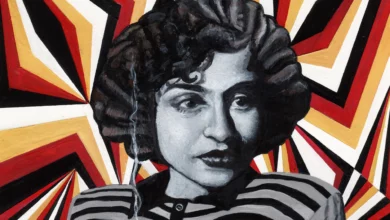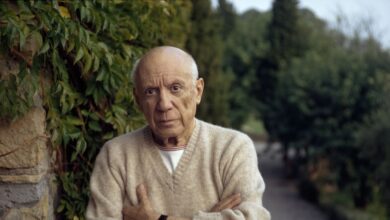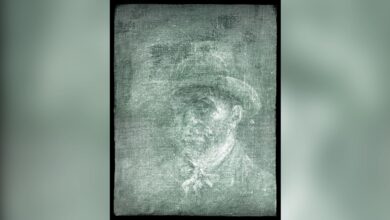Hanging in frames in pristine galleries and museums, or stored carefully in an artist’s studio, off limits for touching or even looking too closely, works of art are often wrapped in layers of mystique and preciousness, treated as perfected, finished objects that should be neither tainted nor changed.
But just as one might be inclined to rip apart pages of painful details from an old diary, or edit thoughts of the past that no longer seem true, widely-exhibited Egyptian painter Hany Rashed seeks to purge his past to better confront the future in his "Black Ice" exhibition at the Gezira Art Center.
“I hope to make works that are relevant to the current events in Egypt. But before doing that, I decided to destroy my old works to have a fresh start,” Rashed told Al-Masry Al-Youm, describing his desire to draw a line between his previous work and future works.
But in his fit of destruction, Rashed also created something new.
“Black Ice” is not the most radical form of artistic destruction to ever take place. In fact it is not really destruction at all. Rashed has attacked a collection of his paintings from recent years with strategically placed blocks of black paint, in ways that create new and surprising images. But while the works maintain an appealing aesthetic, they appear distinctly as though they have been vandalized.
And that is exactly the impression they are meant to give. Rashed describes his feelings about the process of alteration as a kind of catharsis, “I feel that my act of destruction is giving me energy and hope to make new works of art.”
In his artist statement, he wrote, “Through reworking the strong works, I attempt to break the barrier of fear and initiate a more daring approach to art. In reworking weak works, however, I try to open a new start based on exploring possibilities.”
It is difficult to know which works Rashed counts as weak and which strong, but in many paintings the destructive addition becomes part of the narrative of the work. Perhaps this is the mark of a painter who cannot help but paint constructively.
The paintings “In the Garden,” “In the Ballroom,” and “Memories Photo,” all feature a group of blank, white-faced, well-dressed people standing together as if posing for a group photo. The original paintings have the ghostly quality of the imprint of memory, with dramatic color planes filling out shadowy, dream-like environments. In each instance, the addition of black is a grim intruder on an already unsettlingly static scene, a dark cloud taking over an uncomfortable idyll.
Whatever the objects created and destroyed, the destruction of artwork is often simply a performance. One of the most famous art destroyers, Gustav Metzger, built “auto-destructive art,” works engineered to eventually destroy themselves. Staging performances of destruction, such as “Acid action painting,” in which he sprayed acid paint on nylon. Artistic destruction was for Metzger an expression of anger at a world that produces massively destructive forces, like Nazism, nuclear weapons and global warming, and the performance of destruction was the essence of the work.
For Rashed, the act of artistic destruction is less destructive and more personal, but it is no less of a performance. “Black Ice” includes, along with the paintings, a video of Rashed painting over his work, and during the opening reception, Rashed painted over one final piece in a live performance. The act of rejecting old work is of central importance to Rashed.
But as much as Rashed has defaced his own paintings, the resulting work continues to be aesthetically intriguing, and in many cases the altered work presents itself as a kind of sequel to the work destroyed. Rashed’s aim, unlike Metzger’s, is transformative destruction, rather than total destruction. The impetus behind “Black Ice” is essentially a hopeful one. Rashed is full of hope. He hopes that by turning his back so dramatically on the past, he will become free to produce something newer, purer and better. He hopes for a truly fresh start to parallel what he hopes will also be a fresh start in Egypt.
“In my upcoming shows, people will feel that the works take a new direction that is more relevant,” he promises.
But “Black Ice” is relevant in and of itself. It represents an artist’s response to ongoing change in Egypt that, for once, does not glorify or even comment directly on recent political events. This act of personal vandalism is instead an emphatic attempt to free oneself from nostalgia, to internalize the meaning of revolution, and to force a forward looking vision.
“Black Ice” is on display at the Gezira Art Center, 1 Marsafy St., Zamalek, Cairo. The art center is open daily, except Fridays, from 10 am to 2 pm and 5 pm to 9 pm. Tel.: 2737-3298




